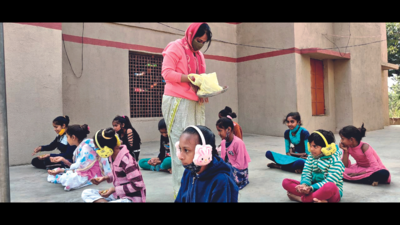- News
- City News
- ahmedabad News
- Gur, chana & sing: Teacher draws up lesson against malnourishment in Gujarat
Trending
This story is from June 17, 2022
Gur, chana & sing: Teacher draws up lesson against malnourishment in Gujarat
As Gujarat battles malnourishment challenge, a school teacher in a remote Aravalli district has demonstrated that tough battles can be won with simple strategies alone.

In January 2022, a survey by the Becharpura Primary School found two-thirds of the 75 girls were underweight, weighing below 30 kg
AHMEDABAD: As Gujarat battles malnourishment challenge, a school teacher in a remote Aravalli district has demonstrated that tough battles can be won with simple strategies alone. She asked for no extra money or fortified food packets from the government but sent health parameters including weight and haemoglobin levels of 75-odd class 6 to 8 school girls zooming by feeding them fistfuls of traditionally acclaimed super-foods — the humble gur (jaggery), chana (roasted chickpeas) and sing (peanuts).
Principal of Becharpura Primary School in backward Bhiloda taluka of Aravalli district Jignyasa Dave says that a chance conversation about malnourishment among the staff led them to check the health of the girls. They were conscious that schools had remained shut for a long period due to Covid pandemic resulting in non-provision of mid-day meals which may have adversely impacted the nourishment status of kids. In January 2022, their survey found two-thirds of the 75 girls were under-weight, weighing below 30 kg. More shocking was that the majority had blood haemoglobin levels of 7 and 7.5 against the normal 12-15 gms/dL.
A closer look in the lunch boxes revealed that most carried just rotis, sometimes accompanied with thin potato curry. For snacks, students spent Rs 5-10 on buying junk food like packets of chips and spiced rice krispies.
"It was obvious that nutrition was missing. We started by asking parents who distribute sweets on kids' birthdays to replace candies with peanuts, chana and jaggery. When these were donated in sacks, we started ensuring each child ate a fistful of each," says Dave.
Four month later, the results were astounding. "By May, majority girls had haemoglobin levels ranging between 9 and 10.5 while in some girls they rose as high as 11. On an average, each girl also puts on one to one and half kg weight," says Dave.
Medical officer R D Asari of Kushi PHC said that 60% of girls had anaemia problems which have shown significant correction.
Sameer Patel, Integrated Child Development Scheme (ICDS) programme officer, says that in wake of this initiative, they provided a sackful of peanuts to the school. "Regular uptake of protein-rich snacks has yielded good results. We are hopeful of emulating this simple initiative in neighbouring schools too," says Patel.
Nainaben Parmar, who runs a small grocery store near the school, says they only sell small packets of gur, chana and sing and have completely stopped selling fried snacks to children. "My daughters have become healthier. As a mother, I feel we should revert back to our ancient nutrition intelligence to ward off anemia and other diseases," she said.
Principal of Becharpura Primary School in backward Bhiloda taluka of Aravalli district Jignyasa Dave says that a chance conversation about malnourishment among the staff led them to check the health of the girls. They were conscious that schools had remained shut for a long period due to Covid pandemic resulting in non-provision of mid-day meals which may have adversely impacted the nourishment status of kids. In January 2022, their survey found two-thirds of the 75 girls were under-weight, weighing below 30 kg. More shocking was that the majority had blood haemoglobin levels of 7 and 7.5 against the normal 12-15 gms/dL.
A closer look in the lunch boxes revealed that most carried just rotis, sometimes accompanied with thin potato curry. For snacks, students spent Rs 5-10 on buying junk food like packets of chips and spiced rice krispies.
"It was obvious that nutrition was missing. We started by asking parents who distribute sweets on kids' birthdays to replace candies with peanuts, chana and jaggery. When these were donated in sacks, we started ensuring each child ate a fistful of each," says Dave.
In the next step, two stores around the school were convinced to stop sale of packaged snacks and instead sell Rs 5 packets of chana, sing and dates. Students and parents were educated who agreed to support the experiment.
Four month later, the results were astounding. "By May, majority girls had haemoglobin levels ranging between 9 and 10.5 while in some girls they rose as high as 11. On an average, each girl also puts on one to one and half kg weight," says Dave.
Medical officer R D Asari of Kushi PHC said that 60% of girls had anaemia problems which have shown significant correction.
Sameer Patel, Integrated Child Development Scheme (ICDS) programme officer, says that in wake of this initiative, they provided a sackful of peanuts to the school. "Regular uptake of protein-rich snacks has yielded good results. We are hopeful of emulating this simple initiative in neighbouring schools too," says Patel.
Nainaben Parmar, who runs a small grocery store near the school, says they only sell small packets of gur, chana and sing and have completely stopped selling fried snacks to children. "My daughters have become healthier. As a mother, I feel we should revert back to our ancient nutrition intelligence to ward off anemia and other diseases," she said.
End of Article
FOLLOW US ON SOCIAL MEDIA











